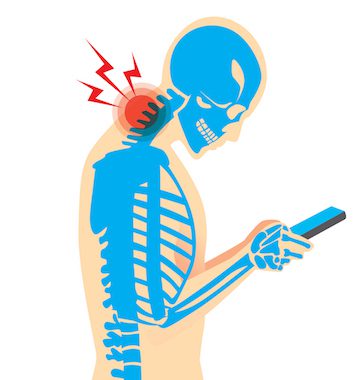
Chances are you own a smartphone. You might even be reading this article on one right now. If you are, stop for a second and notice how you are holding your phone. What position is your head in compared to your shoulders? Are you having any pain? What would your mother say about your posture?
If it’s bad, you might be one of many people suffering from iHunch, or text neck. While this is not an official medical diagnosis, poor posture, especially the contortions we can get into when absorbed by the content on our phones, can result in neck and shoulder pain.
Amy Cuddy, a Harvard researcher famous for her TED talk on power poses, also says this slouched posture can affect our mood in negative ways. Read her op-ed in the New York Times here, for more on that.
Nearly three quarters of all Americans own a smartphone, according to a 2015 Pew Research survey. And for many people, their smartphone is their main gateway to the internet and social communication. Text messaging is the most widely used feature on smartphones today, especially among young adults.
This means, we spend a lot of time staring down at a tiny screen in our hand and that can make for some slouchy positions. Just take a look around the next time you are in a crowded space and you’ll see what I mean.
We know really bad posture when we see it, but what exactly is good posture?
Having good posture is more accurately described as having a neutral spine. A neutral spine is an upright position where the bones of the spine, head and shoulders are lined up as nature intended. It is a position that allows our muscles, joints, and internal organs to function optimally and under the least amount of stress.

Neutral spine left compared with poor alignment on the right
A neutral spine has some natural curves in it, but allows a plumb line to hang straight down from head to foot, more or less. See the image above. With a neutral spine, your ear should line up with your shoulder.
The more your head moves forward away from this neutral position, the more force is exerted on your neck. The average human head weighs between 10 and 12 pounds. Just shifting the head 15 degrees forward increases the strain on the neck to 27 pounds.The stress on the neck goes up to nearly 50 pounds when the head is bent forward 45 degrees. You can learn more and see a terrific graphic of these forces and angles in relation to a mobile phone in this article here.
So, what is the answer? Stop using our phones??
Ack. Perish the thought.
Phones are only going to get cooler and our dependence on them greater. Instead we need to learn how to use them better.
- Start paying attention to how you use your phone and how often.
- Make an effort to bring your phone up to eye level instead of always bending your head down.
- Get to know the voice activated features so you can take your eyes off the phone.
- Use earbuds with a speaker to free your head from your phone.
- Do neck and shoulder exercises to keep your neck mobile.
- Take a break—go on a cell-phone diet now and again.
If you are having pain in your neck or shoulders that won’t go away or has you concerned, ask your physician about it. In fact, you can probably make an appointment right now from your smartphone.
Top image: © logo3in1/Dollar Photo Club
Center photo: © undrey/Dollar Photo Club

